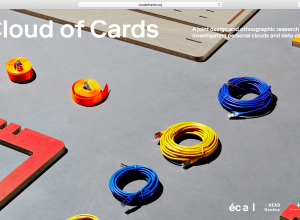Note: an interesting “documentary” project/resource for our project is this recent work by designer and researcher Timo Arnall. It was published last May on his website and on different blogs. The focus is obviously here on the data center as a (fascinating?) contemporary artifact, in which the search for technical efficiency, rationality, security, redundancy, clean air, modularity, etc. leads to a specific spatial aesthetic. It is this aesthetic that seems to become the “main character” for this movie that mixes techniques, even so the idea is to reveal/desacralize the “hidden materiality of our data”. This project is planned to be displayed as a multi-screen installation.
While I didn’t have the occasion to see the movie yet, we should keep it in mind and try to display it in the frame of our own research, in particular to the students that will take part to the different I&IC workshops.
Via elasticspace
—–
Internet machine is a multi-screen film about the invisible infrastructures of the internet. The film reveals the hidden materiality of our data by exploring some of the machines through which ‘the cloud’ is transmitted and transformed.
Film: 6 min 40 sec, digital 4K, 25fps, stereo.
Installation: Digital projection, 3 x 16:10 screens, each 4.85m x 2.8m.
Medium: Digital photography, photogrammetry and 3D animation.
Internet machine (showing now at Big Bang Data or watch the trailer) documents one of the largest, most secure and ‘fault-tolerant’ data-centres in the world, run by Telefonica in Alcalá, Spain. The film explores these hidden architectures with a wide, slowly moving camera. The subtle changes in perspective encourage contemplative reflection on the spaces where internet data and connectivity are being managed.
In this film I wanted to look beyond the childish myth of ‘the cloud’, to investigate what the infrastructures of the internet actually look like. It felt important to be able to see and hear the energy that goes into powering these machines, and the associated systems for securing, cooling and maintaining them.

What we find, after being led through layers of identification and security far higher than any airport, are deafeningly noisy rooms cocooning racks of servers and routers. In these spaces you are buffeted by hot and cold air that blusters through everything.

Server rooms are kept cool through quiet, airy ‘plenary’ corridors that divide the overall space. There are fibre optic connections routed through multiple, redundant, paths across the building. In the labyrinthine corridors of the basement, these cables connect to the wider internet through holes in rough concrete walls.

Power is supplied not only through the mains, but backed up with warm caverns of lead batteries, managed by gently buzzing cabinets of relays and switches.

These are backed up in turn by rows of yellow generators, supplied by diesel storage tanks and contracts with fuel supply companies so that the data centre can run indefinitely until power returns.

The outside of the building is a facade of enormous stainless steel water tanks, containing tens of thousands of litres of cool water, sitting there in case of fire.

And up on the roof, to the sound of birdsong, is a football-pitch sized array of shiny aluminium ‘chillers’ that filter and cool the air going into the building.

In experiencing these machines at work, we start to understand that the internet is not a weightless, immaterial, invisible cloud, and instead to appreciate it as a very distinct physical, architectural and material system.
Production

This was a particularly exciting project, a chance for an ambitious and experimental location shoot in a complex environment. Telefónica were particularly accommodating and allowed unprecedented access to shoot across the entire building, not just in the ‘spectacular’ server rooms. Thirty two locations were shot inside the data centre over the course of two days, followed by five weeks of post-production.

I had to invent some new production methods to create a three-screen installation, based on some techniques I developed over ten years ago. The film was shot using both video and stills, using a panoramic head and a Canon 5D mkIII. The video was shot using the Magic Lantern RAW module on the 5D, while the RAW stills were processed in Lightroom and stitched together using Photoshop and Hugin.

The footage was then converted into 3D scenes using camera calibration techniques, so that entirely new camera movements could be created with a virtual three-camera rig. The final multi-screen installation is played out in 4K projected across three screens.
There are more photos available at Flickr.
Internet machine is part of BIG BANG DATA, open from 9 May 2014 until 26 October 2014 at CCCB (Barcelona) and from February-May 2015 at Fundación Telefónica (Madrid).
Internet Machine is produced by Timo Arnall, Centre de Cultura Contemporània de Barcelona – CCCB, and Fundación Telefónica. Thanks to José Luis de Vicente, Olga Subiros, Cira Pérez and María Paula Baylac.



0 Comments